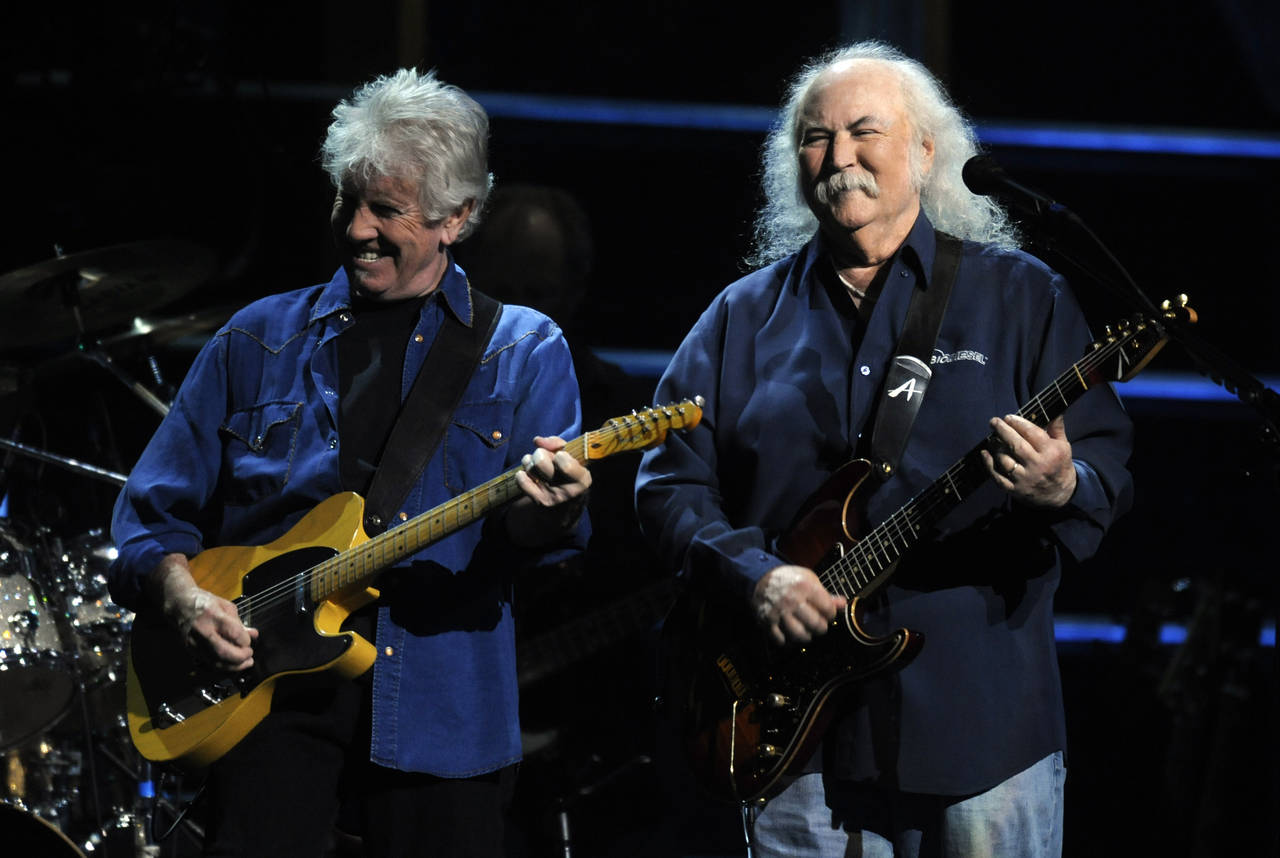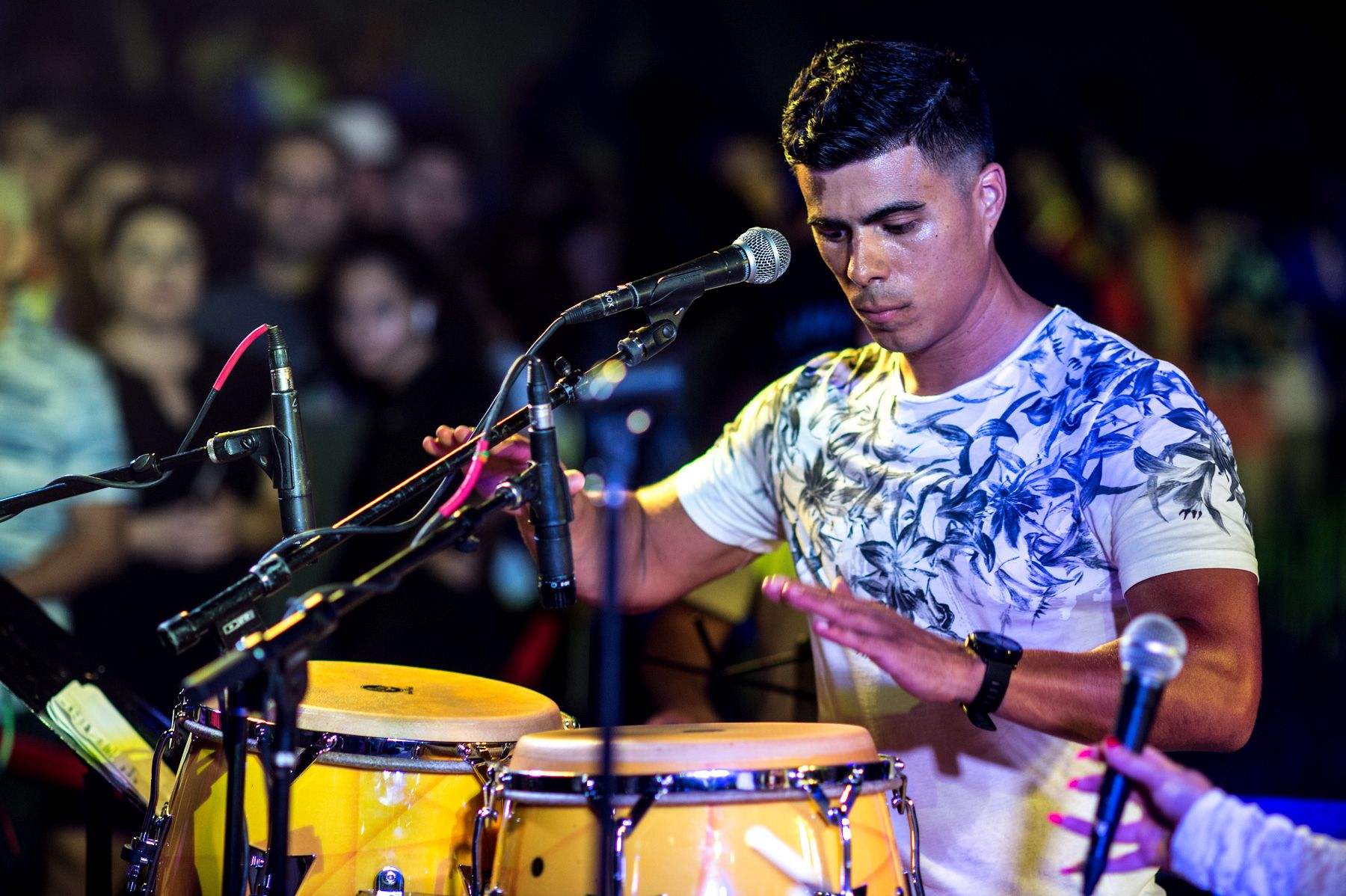

Rock
How Did Latin Music Influence Rock Music?
Modified: January 22, 2024
Discover the powerful influence of Latin music on the evolution of rock music, as these two genres intertwine to create a unique and dynamic sound. Explore the rich history and cultural fusion that has shaped the rock music we know and love today.
(Many of the links in this article redirect to a specific reviewed product. Your purchase of these products through affiliate links helps to generate commission for AudioLover.com, at no extra cost. Learn more)
Table of Contents
Introduction
Latin music and rock music are two distinct genres that have had a significant impact on the music industry. While their styles and origins may seem worlds apart, there is a rich history of cross-pollination between these genres that has shaped the evolution of rock music.
Latin music encompasses a wide range of styles, including salsa, merengue, bossa nova, and reggaeton, among others. Rooted in the diverse musical traditions of Latin America, it is characterized by infectious rhythms, lively melodies, and passionate vocal performances. On the other hand, rock music emerged in the mid-20th century as a fusion of various musical styles, including blues, country, and rhythm and blues. It is characterized by its electric guitar-driven sound, powerful vocals, and rebellious attitude.
However, despite their seemingly different worlds, Latin music and rock music have intersected and influenced each other throughout history. This fusion has not only enriched the musical landscape but has also given rise to new subgenres and styles that continue to captivate audiences worldwide.
In this article, we will explore the fascinating journey of how Latin music influenced rock music. We will examine the origins of Latin music, the emergence of rock music, and the various ways in which these two genres have intertwined. We will delve into the incorporation of Latin rhythms and instruments in rock music, the influential Latin artists who have made their mark in the rock scene, and the rise of Latin fusion and Rock en Español. Lastly, we will discuss the impact of Latin music on rock music today.
Join us on this musical journey as we uncover the dynamic relationship between Latin music and rock music, showcasing the cultural exchange and creativity that has shaped the face of popular music as we know it.
The Origins of Latin Music
In order to understand the influence of Latin music on rock music, it is crucial to explore the rich and diverse origins of Latin music itself. Latin music is deeply rooted in the cultural heritage of Latin America, which encompasses a vast array of countries, each with its own unique traditions and musical styles.
One of the earliest influences on Latin music can be traced back to the indigenous peoples of Latin America, who developed their own musical traditions long before the arrival of Europeans. These indigenous cultures used various instruments such as drums, flutes, and maracas to create rhythmic and melodic music, often intertwined with spiritual rituals and ceremonies.
With the colonization of Latin America by European powers, namely Spain and Portugal, the music of these European countries began to intertwine with the indigenous music. This fusion gave birth to various styles, such as the Afro-Cuban rhythms that emerged through the blending of African and European musical traditions in Cuba.
Furthermore, the African diaspora played a significant role in the development of Latin music. During the transatlantic slave trade, millions of Africans were brought to Latin America, bringing with them their own musical traditions. The rhythmic and percussive elements of African music heavily influenced Latin American genres such as salsa and samba, infusing them with infectious beats and energetic dance styles.
In addition to these influences, Latin music also drew inspiration from the European classical traditions, particularly during the 19th and early 20th centuries. Composers such as Heitor Villa-Lobos from Brazil and Manuel De Falla from Spain incorporated folk elements into their compositions, creating a unique fusion of classical and folk music.
The rise of radio and recording technology in the 20th century further contributed to the dissemination and popularization of Latin music. Artists such as Tito Puente, Celia Cruz, and Carlos Gardel gained international acclaim, taking Latin music beyond its regional boundaries and captivating audiences around the world.
The origins of Latin music are deeply tied to the history, culture, and influences of Latin America. Its diverse blend of indigenous, European, and African elements has shaped a vibrant and captivating musical tradition that continues to evolve and inspire musicians and listeners alike.
The Emergence of Rock Music
Rock music emerged in the mid-20th century as a rebellious and energetic response to the prevailing musical trends of the time. It was born out of a fusion of various musical genres, including rhythm and blues, country, and blues. The roots of rock music can be traced back to the 1940s and 1950s, when artists such as Chuck Berry, Little Richard, and Elvis Presley pioneered the sound that would revolutionize the music industry.
At its core, rock music is characterized by its electric guitar-driven sound, aggressive and passionate vocals, and a rebellious attitude. It became a powerful vehicle for self-expression and counter-cultural movements, capturing the spirit of rebellion and individualism.
Rock music gained widespread popularity in the 1960s, often referred to as the “golden age” of rock. This era saw the rise of iconic rock bands such as The Beatles, The Rolling Stones, and The Who, who pushed the boundaries of the genre and brought it to a global audience.
The 1970s witnessed the diversification of rock music, with the emergence of subgenres such as glam rock, punk rock, and progressive rock. Each subgenre brought its own unique sound and style, appealing to different audiences and pushing the boundaries of rock even further.
In the following decades, rock music continued to evolve and adapt to the changing times, giving rise to various offshoots and styles, including alternative rock, grunge, and indie rock. Despite the rise of other popular genres, rock music has remained a powerful force in the music industry, with bands like Foo Fighters, Muse, and Arctic Monkeys carrying the torch for the genre.
The emergence of rock music symbolized a cultural shift, breaking away from the traditional and conservative norms of society. It became a platform for self-expression, rebellion, and the amplification of social and political messages.
Today, rock music continues to be a driving force in the music industry, with its enduring popularity and influence. Its impact can be felt in various genres, as well as in the fusion of cultural influences, including the incorporation of Latin music elements.
As we delve into the intersection of Latin music and rock music, it is important to recognize the powerful and transformative journey that both genres have taken, shaping the musical landscape and inspiring generations of musicians and listeners.
The Intersection of Latin Music and Rock Music
The intersection of Latin music and rock music has been a dynamic and influential relationship that has shaped the evolution of both genres. The fusion of Latin rhythms, instruments, and vocal styles with the electric energy of rock music has created a unique and captivating sound that has resonated with audiences around the world.
One of the key elements of Latin music that found its way into rock music is the infectious rhythm. Latin rhythms, such as the clave beat, the syncopated patterns of salsa, and the driving percussion of Afro-Cuban music, infused rock with a new sense of groove and movement. Bands like Santana and Los Lobos incorporated Latin rhythms into their rock repertoire, creating a fusion that appealed to a broad audience and introduced them to the vibrant world of Latin music.
In addition to rhythm, Latin instruments have also made their mark in rock music. The use of instruments such as congas, bongos, and timbales added a distinctive flair and texture to rock songs. The iconic drumming style of Santana’s Michael Shrieve and the incorporation of Latin percussion in songs like “Oye Como Va” showcased the seamless blending of Latin and rock elements.
Furthermore, the vocal styles and emotions of Latin music found their place in rock music as well. Latin singers, with their passionate and expressive delivery, brought a new level of intensity and emotion to rock songs. Artists like Ritchie Valens and Carlos Santana infused their performances with the soulfulness and vibrancy of Latin music, creating an undeniable connection with their audiences.
The influence of Latin music on rock can also be seen in the lyrics and themes tackled in songs. Latin music often explores themes of love, passion, and social issues, which resonated with rock musicians seeking to convey deeper messages through their music. The fusion of Latin and rock lyrics added layers of meaning and added a new dimension to the genre.
This intersection of Latin music and rock music has not only enriched the sound and diversity of rock but has also brought Latin music to a wider audience. It has broadened the horizons of both musicians and listeners, fostering cultural exchange and appreciation.
With the emergence of Latin fusion and Rock en Español in the 1980s and 1990s, the blending of Latin and rock elements reached new heights. Bands like Maná, Café Tacvba, and Aterciopelados incorporated rock instruments and aesthetics into their Latin music, creating a fresh and innovative sound that resonated with Latin American audiences and beyond.
The intersection of Latin music and rock music continues to evolve and thrive today. Artists and bands from all over the world are embracing this fusion, creating music that defies traditional genre boundaries and speaks to the universal love for rhythm, melody, and emotion.
This ongoing cross-pollination between Latin music and rock music serves as a testament to the power of music to transcend cultural barriers and create something truly unique and captivating.
Latin Rhythms and Instruments in Rock Music
The incorporation of Latin rhythms and instruments in rock music has added a vibrant and dynamic element to the genre. This fusion has not only expanded the sonic palette of rock but has also infused it with the infectious energy of Latin music.
Latin rhythms, known for their lively and syncopated beats, have found their way into rock songs, enhancing the groove and creating a unique rhythmic foundation. The clave beat, a fundamental rhythmic pattern in Latin music, has been embraced by rock musicians and has become a staple in many songs. This driving rhythm provides a distinct Latin flavor and adds an irresistible element of movement to the music.
Additionally, the use of Latin percussion instruments has become a defining characteristic of the fusion between Latin music and rock. Instruments such as congas, bongos, timbales, and cowbells have been incorporated into rock songs, adding a layer of texture and rhythm. The rhythmic patterns and distinctive sounds of these instruments create an exciting blend when combined with the drums and guitars traditionally associated with rock music.
One example of the use of Latin rhythms and instruments in rock music is the band Santana. Led by guitar virtuoso Carlos Santana, the band seamlessly integrated Latin influences into their rock sound. Songs like “Oye Como Va” and “Black Magic Woman” showcase the fusion of Latin percussion and rhythms with Santana’s iconic guitar playing, creating a unique and instantly recognizable sound.
Another prominent example is the band Los Lobos, who incorporated elements of Mexican folk music and Latin rhythms into their rock compositions. With songs like “La Bamba” and “Cumbia Raza,” they brought the energy and authenticity of Latin traditions into the mainstream rock scene, garnering critical acclaim and a dedicated fan base.
Latin rhythms and instruments have also found their way into other subgenres of rock. In the realm of alternative rock, bands like Manu Chao and Gogol Bordello infuse their energetic sound with elements of Latin music, creating a fusion that transcends cultural boundaries and electrifies audiences.
The incorporation of Latin rhythms and instruments in rock music has not only expanded the sonic possibilities but has also bridged the gap between different cultures and musical traditions. It has brought forth a new wave of creativity and innovation, showcasing the richness and diversity of Latin music and its ability to blend seamlessly with other genres.
This fusion has created a unique and exciting musical landscape, drawing listeners from all walks of life into the infectious rhythms and captivating melodies that result from the marriage of Latin and rock influences. The utilization of Latin rhythms and instruments in rock music has undoubtedly enhanced the genre’s vibrancy and appeal, opening new avenues for exploration and expression.
Influential Latin Artists in Rock Music
The influence of Latin music in rock extends beyond the incorporation of rhythms and instruments. There have been numerous influential Latin artists who have made their mark in the world of rock music, pushing boundaries and inspiring generations of musicians.
Carlos Santana, with his iconic guitar playing and fusion of Latin, rock, and blues influences, is undoubtedly one of the most prominent Latin artists in rock. Santana’s distinct sound and virtuosic guitar solos, combined with his passionate performances, have garnered critical acclaim and a loyal following. His hit songs like “Black Magic Woman” and “Smooth” exemplify his ability to seamlessly blend Latin rhythms with rock sensibilities, creating a sound that transcends genres.
Richie Valens, a Mexican-American artist, played a pivotal role in the early days of rock and roll. His energetic rock performances and Latin-infused style became an important influence on subsequent generations of musicians. Valens’ timeless hits like “La Bamba” showcased his ability to blend Latin rhythms with a rock and roll sound, paving the way for future Latin rock artists.
Los Lobos, a Chicano rock band formed in East Los Angeles, has had a significant impact on the fusion of Latin and rock music. Their unique sound, incorporating elements of Mexican folk and Latin rhythms, has earned them critical acclaim and a dedicated fan base. Songs like “La Bamba” and “Kiko and the Lavender Moon” epitomize their ability to infuse Latin influences into rock music seamlessly.
The Argentine band Soda Stereo, led by Gustavo Cerati, played an important role in the development of Latin rock in the 1980s and 1990s. Their innovative sound combined elements of new wave, post-punk, and rock with Latin influences, creating a fresh and distinctive style. Their music broke barriers, contributing to the emergence of Rock en Español and influencing a new generation of Latin rock artists.
Maná, a Mexican rock band, has achieved massive popularity and success, both in Latin America and internationally. Their anthemic rock songs, often addressing social and political issues, resonate with audiences across cultures. Maná’s ability to infuse Latin rhythms and melodies into their rock sound has made them one of the most influential Latin rock bands of all time.
These artists, among many others, have played a pivotal role in bridging the gap between rock and Latin music. They have demonstrated that expressing cultural identity and embracing diversity can enrich the musical landscape and create a powerful connection with audiences around the world.
As Latin music continues to evolve and transform, the influence of these groundbreaking artists in rock music serves as an inspiration for future generations, reminding them of the unique possibilities that exist when different genres and traditions intersect.
Latin Fusion and Rock En Español
Latin fusion and Rock en Español emerged as powerful movements in the late 20th century, blending Latin music with rock elements and lyrics in Spanish. These movements not only brought Latin rhythms and influences to the forefront of rock music but also led to the global recognition of artists who embraced these innovative styles.
Latin fusion, as the name suggests, blends Latin music with various other genres, including rock, jazz, funk, and hip-hop. This fusion of styles created a diverse and vibrant musical landscape, giving rise to a new generation of artists who blurred the lines between genres. One of the pioneers of Latin fusion was the band Ozomatli, known for their unique blend of Latin, hip-hop, rock, and world music. Their infectious rhythms, bilingual lyrics, and socially conscious themes captivated audiences and showcased the power of cultural fusion.
Rock en Español, on the other hand, refers specifically to the rock music movement in Spanish-speaking countries. This genre gained prominence in the 1980s as a response to the dominance of English-language rock music. Rock en Español played a crucial role in bringing Latin rock to the forefront, with bands like Soda Stereo, Caifanes, and Aterciopelados gaining international acclaim. These artists incorporated rock and pop influences into their music, delivering powerful and evocative performances that resonated with Latin American audiences.
The impact of Latin fusion and Rock en Español goes beyond their musical contributions. These movements brought attention to Latin American culture, enabling artists to celebrate their heritage and express their unique perspectives through their music. They played a significant role in breaking down cultural barriers and fostering a sense of unity among diverse audiences.
Latin fusion and Rock en Español continue to inspire and influence contemporary musicians. Artists like Juanes, Manu Chao, and Calle 13 have carried the torch, blending Latin rhythms and rock energy with their own unique styles and messages. Their music resonates not only with Latin American audiences but with listeners across the globe, showcasing the universal appeal of this fusion.
The success of Latin fusion and Rock en Español is a testament to the power of cultural collaboration and the ability of music to transcend language and cultural differences. These movements have not only enriched the rock music scene but have also opened doors for artists from diverse backgrounds to be heard and recognized.
Latin fusion and Rock en Español continue to evolve and thrive, pushing boundaries and breaking new ground in the intersection of Latin music and rock. As artists continue to innovate and explore new horizons, their contributions will undoubtedly shape the future of both genres and inspire a new generation of musicians to embrace the power of cultural fusion.
Latin Music’s Impact on Rock Music Today
Latin music continues to have a significant impact on rock music, shaping the landscape of the genre in countless ways. From the incorporation of Latin rhythms and instruments to the rise of Latin fusion and Rock en Español, the influence of Latin music on rock is undeniable, even in the modern music scene.
One of the notable ways in which Latin music has impacted rock music today is through the exploration of diverse musical influences. Artists and bands from various backgrounds are embracing Latin rhythms and incorporating them into their rock compositions. This infusion of Latin elements adds a unique flavor to their music, creating a fresh and dynamic sound that resonates with audiences.
Furthermore, the popularity and success of Latin artists in recent years have contributed to the increased visibility and acceptance of Latin-influenced rock music. Artists like Rodrigo y Gabriela, a Mexican duo known for their intricate guitar work and fusion of rock and flamenco, have gained worldwide recognition. Their ability to seamlessly blend Latin and rock elements has inspired a new generation of musicians to explore the possibilities of this fusion.
Moreover, the success of Latin rock bands like Molotov and Café Tacvba has opened doors for other Latin artists to explore rock music. These bands have proved that there is an appetite for rock music with Latin influences, encouraging artists to experiment and incorporate Latin elements into their own sound.
Additionally, Latin music’s impact on rock can be seen in collaborations and cross-genre projects. Artists from both Latin and rock backgrounds are collaborating on songs and albums, creating a fusion that defies traditional genre boundaries. These collaborations not only bring different musical styles together but also foster cultural exchange and appreciation.
Social media and digital platforms have also played a significant role in spreading Latin-influenced rock music to a wider audience. With the rise of streaming services and online sharing, artists and fans have more opportunities to connect and discover new music. This accessibility has allowed Latin rock artists to reach listeners around the world, disseminating their unique blend of Latin and rock music to a global audience.
Latin music’s impact on rock music today goes beyond just the sound itself. It represents a celebration of cultural diversity, promoting unity and understanding through music. This exchange of influences creates a musical tapestry that reflects the ever-evolving nature of rock music and its ability to embrace and incorporate different cultures and musical traditions.
As Latin music continues to gain recognition and influence in the mainstream music industry, its impact on rock music will only continue to grow. This ongoing fusion of Latin and rock elements has opened up new creative possibilities and expanded the boundaries of the genre, enriching the musical landscape for both artists and audiences alike.
Conclusion
The intersection of Latin music and rock music has resulted in a dynamic and compelling fusion that has shaped the evolution of both genres. From the origins of Latin music rooted in the diverse cultures of Latin America to the emergence of rock music as a rebellious and powerful force, the paths of these genres have converged, creating a vibrant musical landscape.
The incorporation of Latin rhythms, instruments, vocal styles, and influences in rock music has brought a new level of energy, groove, and cultural richness to the genre. Latin fusion and Rock en Español have further propelled this fusion, giving rise to iconic artists and bands that have made lasting contributions to the music industry.
Moreover, the influence of Latin music on rock music today is evident in the exploration of diverse musical influences, the success and visibility of Latin artists, collaborations, and the accessibility offered by digital platforms. Latin-inspired rock continues to evolve, challenging musical boundaries and fostering cultural unity and appreciation.
The impact of Latin music on rock goes beyond just the music itself; it represents a celebration of cultural exchange, diversity, and the power of music to transcend boundaries. It has provided a platform for artists to express their unique identities and perspectives while creating a universal connection with audiences worldwide.
As we continue to witness the fusion of Latin music and rock music, the future of these genres looks promising. The ongoing creativity and innovation in this fusion showcase the limitless possibilities and potential for collaboration and cultural fusion in the music industry.
In conclusion, the influence of Latin music on rock music is an integral part of the history and evolution of both genres. The incorporation of Latin rhythms, instruments, and influences has enriched the sound, diversity, and global appeal of rock music. The fusion continues to inspire musicians, break down barriers, and create music that transcends cultural boundaries.
As listeners, we are fortunate to experience the vibrant and captivating results of this fusion. Let us continue to embrace and celebrate the power of Latin music in rock, appreciating the cultural connections and creative journeys that have shaped the music we love.











